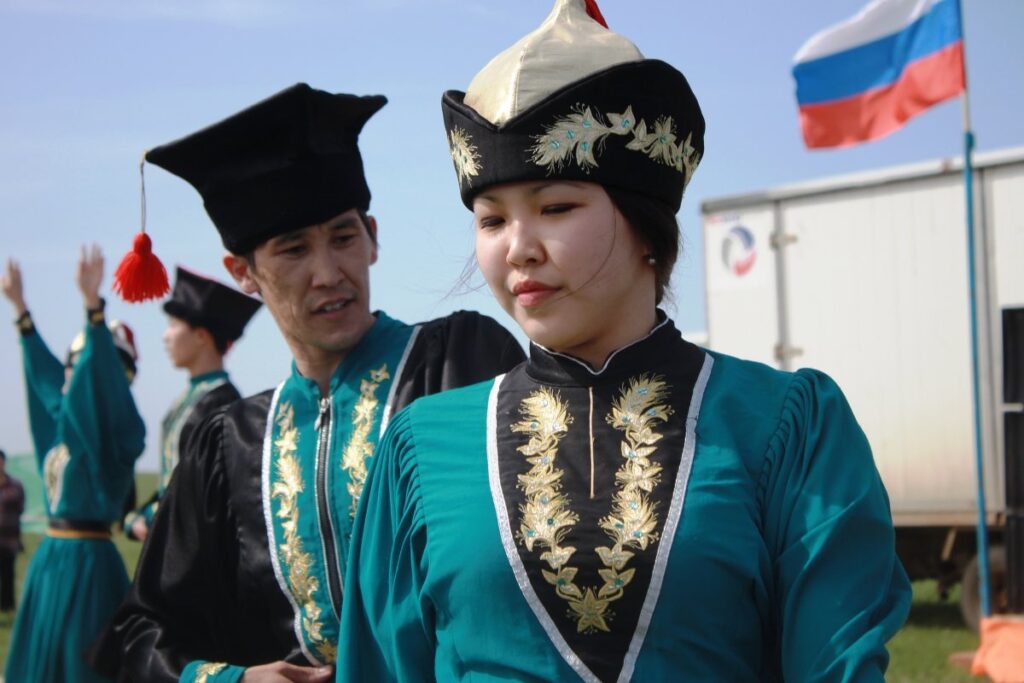Now Derbets are a subethnos or a tribe within the Kalmyk people, depending on which definition is closer to you. Their exact number is difficult to name, the approximate estimate in Russia is 4 thousand. But under the tsarist regime, there was Derbetovsky ulus, which was later divided into two parts and became the basis for several modern districts of the Republic of Kalmykia. It is assumed that the Derbets are the largest of the Kalmyk tribes in the Russian Federation, perhaps more than all the others.

Like all Kalmyks, their history begins in western Mongolia, where an alliance of Oirat tribes formed during the collapse of the Yuan Empire. That is, ethnically, it existed before, but gradually turned into a political association. When the power of the Genghisids fell and the Mongols were expelled from China, the Oirats claimed to rule the entire steppe. But they did not succeed, and these nomads simply created a separate powerful state – the Dzungarian Khanate, the last nomadic empire, only of a new type.
The basis of this power was made up of four Oirat clans: Choros, Torguts, Khoshuts and, in fact, Derbets, but other Mongolian clans joined them at different times. Due to civil strife and military confrontation with the Kazakh Khanate, the Manchus and the Chinese Qing Dynasty of Manchu origin, a number of tribes migrated to the west and eventually came to the Volga region, where the Kalmyk Khanate was founded. Interestingly, they were called Kalmyks by neighboring peoples – this word means «separated» or «stragglers» in Turkic languages.
However, if these three associations begin to be mentioned in the late Middle Ages or even at the beginning of modern times, then the Derbets are an older union and one of the oldest Mongolian clans in general. Its history begins long before Genghis Khan, and the origin is derived from the number of descendants of Borte-Chino, the legendary gray wolf, the ancestor of all Mongolian peoples.
His descendant in the eleventh generation was a blind man named Duva-Sokhor. The four sons of this man did not want to live with their relatives and separated, becoming the founders of the new Dorben tribe («four»). Numerical identification is generally typical for the Turkic and Mongolian peoples, take, for example, the modern Kyrgyz («forty tribes»), the ancient Uch-Oguz («three tribes») and Tokuz-Oguz («nine tribes»).
In the 11th century, the Dorbens were part of the Nirun Mongols — Mongols in a narrow sense, whereas the Darlekin Mongols meant all peoples of the corresponding origin. During the wars preceding the creation of the empire, they supported Temujin’s twin brother, Jamukha.

During the battle in the Koiten tract, the leader of the Dorbens, Khudukha-beki, used the «thunderstone» to send a storm to his opponent’s camp. But the shamans refused more strongly, and the allies themselves suffered from this, and not the army of Genghis Khan. The battle was lost, and the universe shaker got the opportunity to beat his enemies one at a time.
While the Dorbens went to the northern steppes and maintained their independence until the foundation of the Mongol Empire. When Jochi was sent to Siberia in order to conquer the «forest peoples», the Dorbens were among the first to beat his forehead, and their leaders married Mongolian princesses. Since then, the clan has become a participant in the conquests, its contingents, among others, have become the mainstay of the throne in the Hulaguid state.
The Derbets, as an Oirat tribe, appeared only in the 16th century, and we cannot reliably establish to what extent they were related to the ancient Dorbens. On the other hand, they were part of the same nomadic unions, so it is logical to assume that these are their descendants.
At that time, they were led by Taishi Dalai Batyr, who led his clan to the southwest of Siberia and in the 1600s established relations with the Russians. In the tribal alliance that eventually founded the Kalmyk Khanate in the Lower Volga region, his family fought for influence with the leader of the Torguts, Kho-Urlyuk. Some of his sons went to the Volga, where the Torguts and Khoshuts had already settled. And the European Derbets then recognized the power of the Torgut Khan.

But in 1771, the so-called Torgut escape occurred – the mass resettlement of Kalmyk tribes back to Dzungaria in connection with disagreement with the actions of the Russian government. The khanate was abolished, and the Derbets began to dominate the Kalmyk steppes. To a large extent, they became participants in numerous military campaigns and glorified themselves as part of the Russian army. Their military profession is still considered very prestigious.
In 1788, due to a quarrel between two brothers, Derbetovsky ulus collapsed, divided, respectively, into Bolshederbetovsky and Maloderbetovsky. At that time, these were parts of Astrakhan province, then Stavropol province, but now both have become part of the Republic of Kalmykia with slightly changed borders due to migrations.
Now Derbets, as already mentioned, make up a significant part of the Russian Kalmyks. In addition, their descendants live in the Xinjiang Uygur Autonomous Region of China, formerly an integral part of Dzungaria. There are about 75 thousand of them in Mongolia itself, but despite the obvious small number, the family gave the country several famous people.

Caesenbal and his beloved
As an example, we can recall Ja-lama, an Astrakhan Kalmyk who became one of the leaders of the liberation movement against China in the 1910s, and then led the Mongolian anti–communists. On the opposite side, one can name Yumzhagiin Tsedenbal, a Mongolian derbet who headed socialist Mongolia in the 1952-1984’s.
